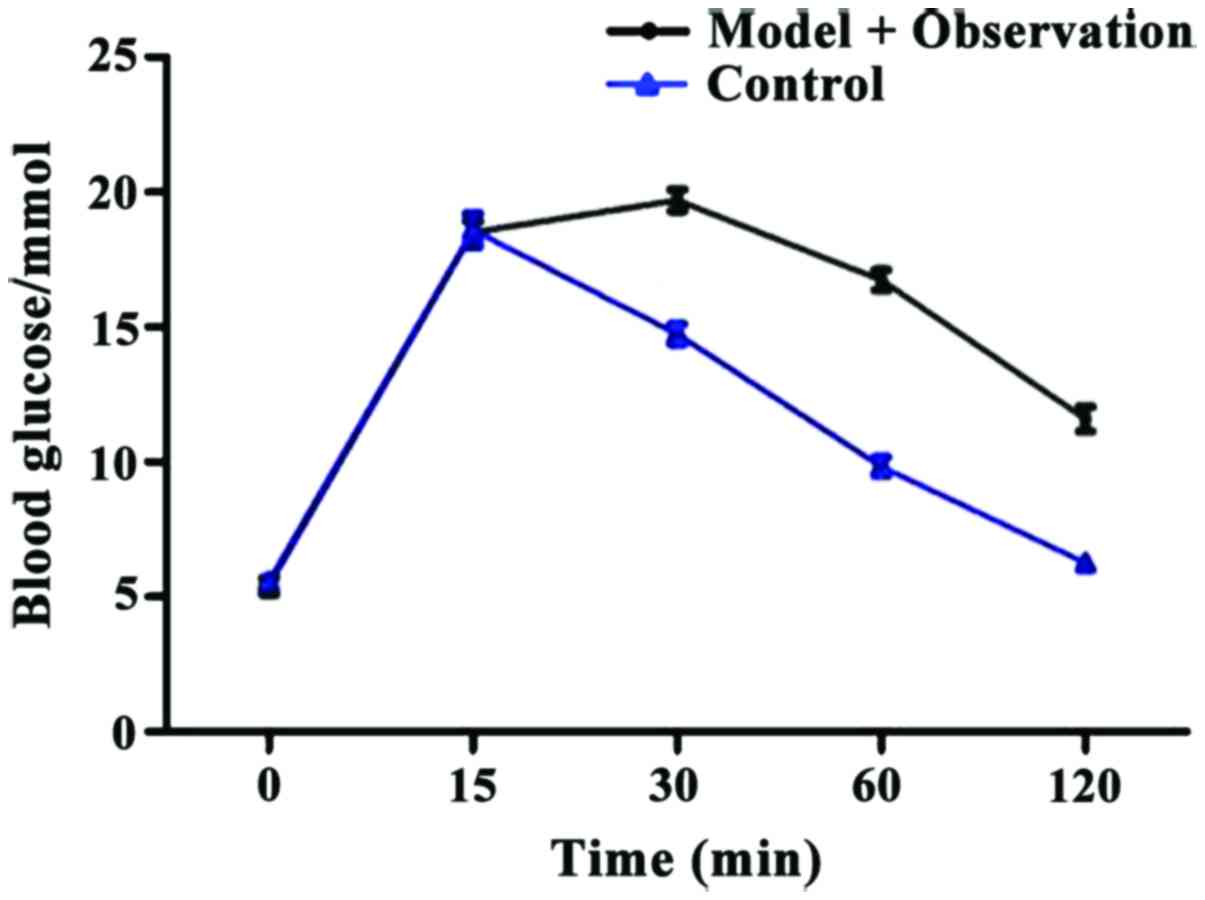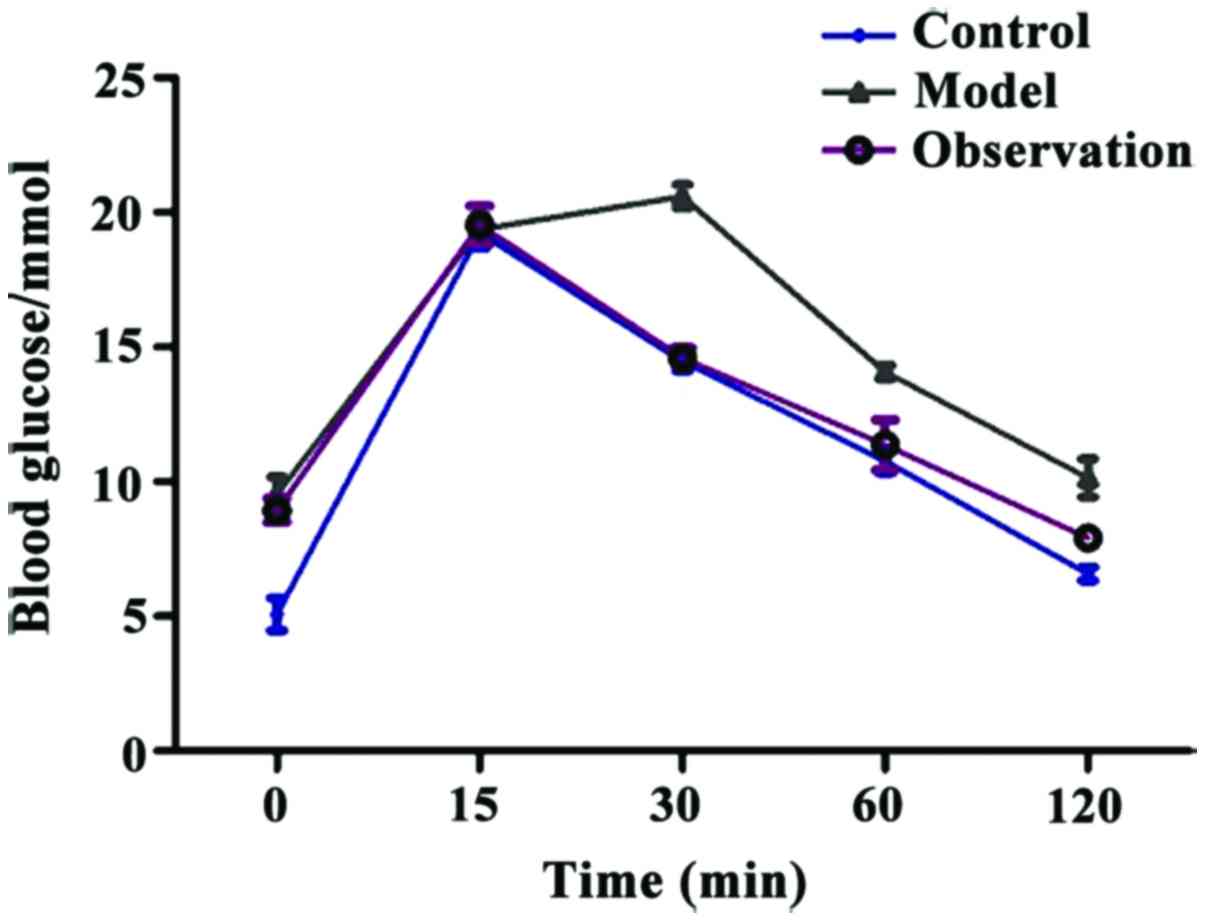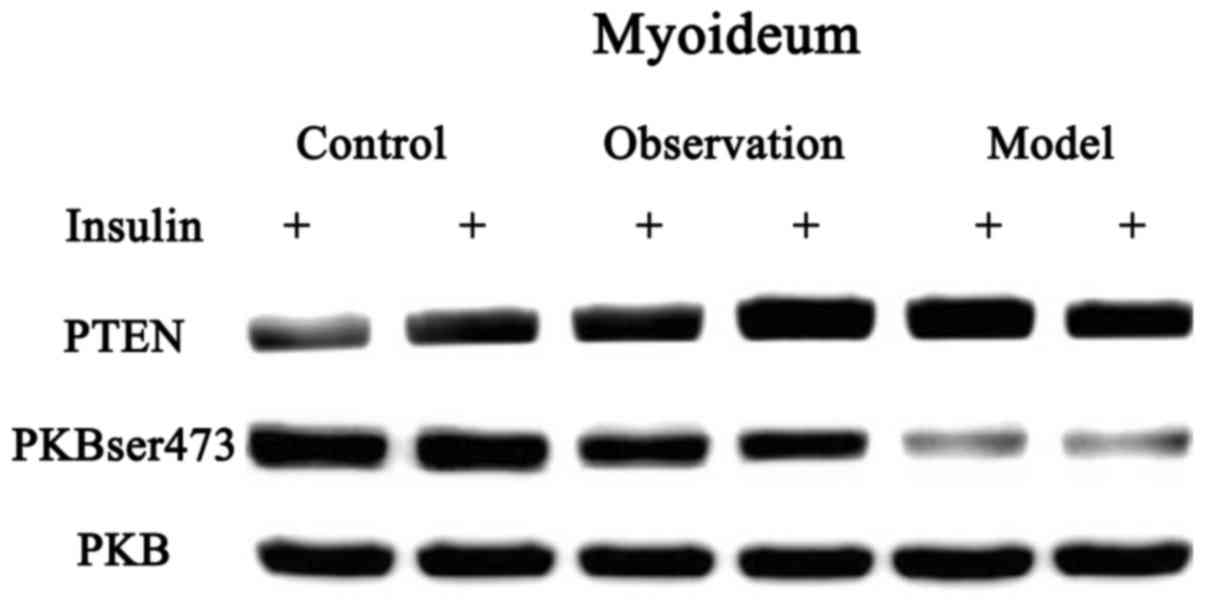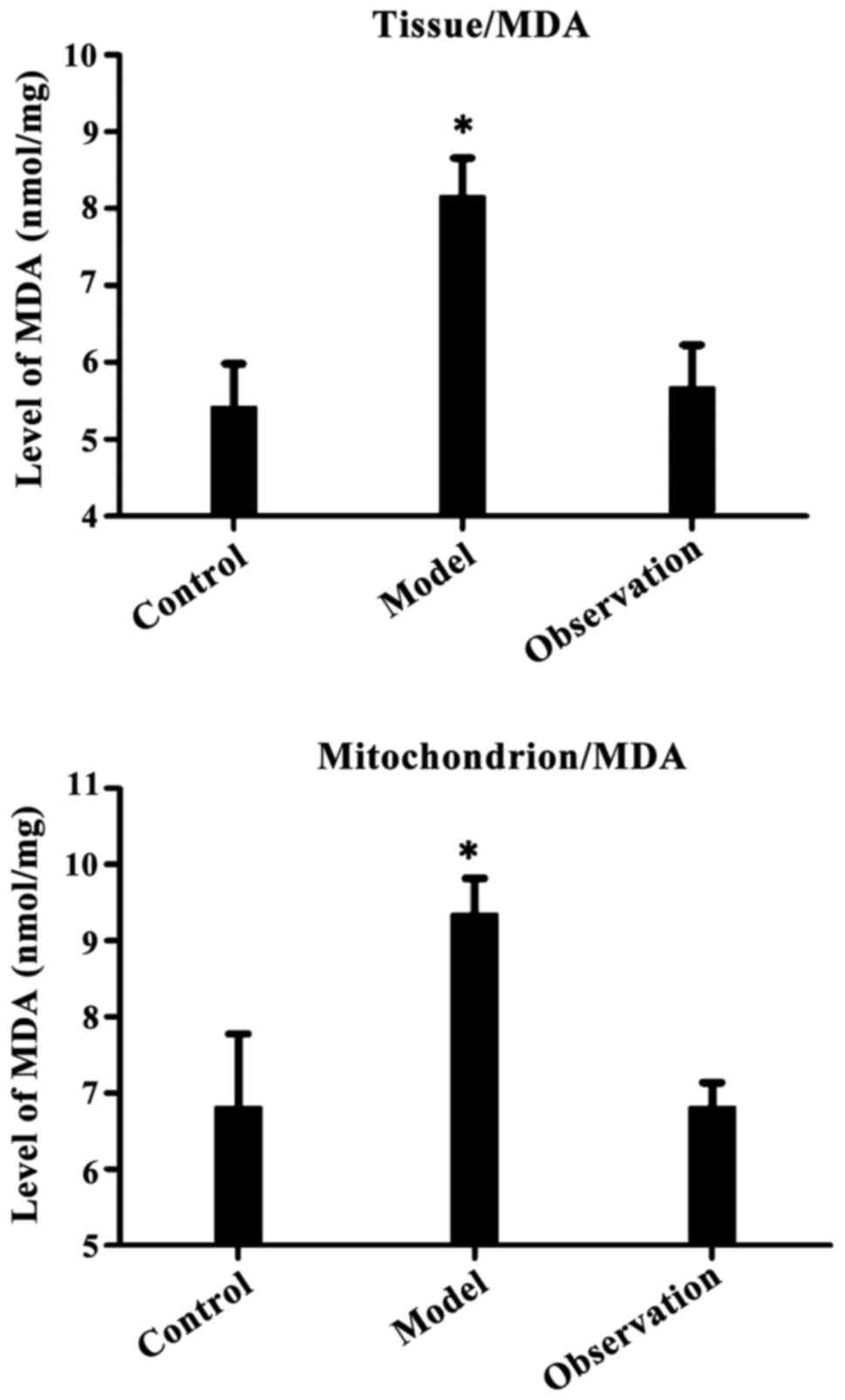Introduction
Type 2 diabetes has a high incidence of the chronic
metabolic diseases, the pathogenesis of which is complex (1). Studies have pointed out that insulin
resistance plays an important role in the occurrence and
development of type 2 diabetes (2).
Paraquat as an organic contact heterocyclic herbicide and defoliant
is widely used at this stage. Paraquat can effectively induce
mitochondria to produce large amounts of peroxide, leading to blood
glucose metabolism disorders and insulin resistance, and can be
used as a drug for the insulin resistance type 2 diabetes model.
Nrf2, an important transcription factor, can effectively regulate
the NQO-1 level to participate in the insulin signal system and
inflammation signal regulation. Rehmannia glutinosa can
effectively enhance the body immunity, reduce blood sugar levels,
and protect the renal function by Traditional Chinese medicine
theory, which is a commonly used for treatment of type 2 diabetes.
However, the biological mechanism of the regulation of blood sugar
is still rarely reported (3). The
water extract of Rehmannia glutinosa has a high retention of
active ingredients and is easy to prepare. In this study, the water
extract of Rehmannia glutinosa was selected as the research
object, used to detect the effect of the water extract of
Rehmannia glutinosa on the Nrf-2 antioxidant system of
diabetic mice induced by paraquat and to provide a basis for its
further development.
Materials and methods
Materials
Glucose, hydroxymethylcellulose sodium (CMC Na) and
paraquat were purchased from Sigma. Insulin was obtained from Novo
Nordisk, Inc. (Bagsvaerd, Denmark). Physiological saline was
purchased from Beijing Jimei Biotech Co., Ltd. (Beijing, China). A
nuclear extraction kit, mitochondria extraction kit, cell lysates
and BCA Protein Concentration Quantitative kit were purchased from
Shanghai Biyuntian Biotechnology Co., Ltd. (Shanghai, China) and
the blood glucose meter was from Roche (Basel, Switzerland). The
primary antibodies of histone-3, PKB, PKBSer473, NQO-1, IincBα,
β-actin and Nrf were obtained from Cell Signaling Technology, Inc.
(Danvers, MA, USA) (cat. nos. 8135, 4691, 9611, 62262, 9242, 8457
and 69432), and the mouse anti-rabbit secondary polyclonal antibody
was from Santa Cruz Biotechnology, Inc. (Philadelphia, PA, USA)
(cat. no. sc-2357).
Preparation of water extracts of
Rehmannia glutinosa
Rehmannia glutinosa (35 g) was soaked in 500
ml water for 30 min at first, after the boiling simmered for 60
min, filtered for juice, then repeated 2 times, the three juices
were mixed, and 80°C water bath concentrated to 0.4 g/ml liquid,
autoclaving.
Animal treatment
In this study, 30 6-week-old male 16–19 g mice were
randomly divided into control group, model control group and
observation group (n=10). Mice in the model control group and the
observation group were injected with 5 mg/kg of paraquat
intraperitoneally for 7 days to induce insulin resistance, and
glucose tolerance was measured on the 8th day according to the
literature (4). Meanwhile mice in
the control group was injected with the same volume of saline.
After model establishment, the mice in the observation group were
treated with 1.2 g/kg·day of the water extracts of Rehmannia
glutinosa, while equal volume of 1% CMC Na was given to the
control group. After 7 days treated with water extracts of
Rehmannia glutinosa, the glucose tolerance was measured
again and the body weight of mice was measured before and after
treatment. The study was approved by the Ethics Committee of the
First Affiliated Hospital of Zhengzhou University.
Extraction of mitochondria and
nuclei
Mouse muscle tissue (70 mg) was used for extraction
of mitochondria and nuclei strictly in accordance with the
manufacturer's instructions.
Determination of malondialdehyde
The level of malondialdehyde in mitochondria and
muscle tissue was detected strictly in accordance with the
manufacturer's instructions.
Protein extraction and western
blotting
In this study, muscle tissue was obtained and the
protein was extracted strictly in accordance with the
manufacturer's instructions. The protein level was determined using
the BCA Protein Concentration Quantitative kit. Protein samples (50
µg) was loaded into SDS-PAGE gel electrophoresis, the protein was
electrophoretically separated. After the electrophoresis, the
protein was transferred to the PVDF membrane, the membrane was
blocked for 2 h with 5% bovine serum albumin, and incubated with
rabbit anti-mouse histone-3, PKB, PKBSer473, NQO-1, IκBα, β-actin
and Nrf polyclonal antibodies (1:500) overnight at 4°C,
respectively. Then the membrane was washed, the HRP labeled mouse
anti-rabbit secondary polyclonal antibody (1:1,000) was incubated
at room temperature for 2 h, and washed again in TBST. The protein
bands on the membrane were detected by enhanced chemiluminescence,
and the gray scale was scanned by automatic gel imaging analyzer,
then the relative gray value was calculated as the expression level
of the protein.
Statistical analysis
In the study, the ImageJ software was used to scale
the gray of bands in western blotting. SPSS 19.0 statistical
analysis software (SPSS, Inc., Chicago, IL, USA) was used to
evaluate the differences of the data in the different groups.
Measurement data were expressed as means ± standard deviation and
the parallel variance analysis was performed. A P-value <0.05
was considered to indicate a statistically significant
difference.
Results
Body weight changes of mice
The results showed that the body weight of the mice
in both the model control group and the observation group was
significantly lower than that in the control group before treatment
(P<0.05). There was no significant difference in the body weight
before and after treatment in the control group (P>0.05), but
the body weight was lower when the modeling time was extended
(P<0.05). There was no significant difference in body weight
before and after treatment (P>0.05), but the body weight of the
observation group was significantly higher than that in model
control group after treatment (P<0.05) (Table I).
 | Table I.Body weight changes of mice. |
Table I.
Body weight changes of mice.
| Groups | Before
intervention | After
intervention |
|---|
| Control | 28.61±0.91 | 29.13±1.23 |
| Model | 26.37±0.84 |
23.94±1.02a,c |
| Observation | 26.48±0.96 |
26.99±1.15a,b |
Water extracts of Rehmannia glutinosa
improves the insulin resistance induced by paraquat
The glucose tolerance of mice in both the model
control group and experiment group was impaired significantly after
modeling for 7 days, as shown in Fig.
1. In the mice treated with water extracts of Rehmannia
glutinosa for 7 days, the blood glucose level was significantly
decreased (P<0.05), as shown in Fig.
2. The results of western blotting in Fig. 3 shows that the phosphorylation level
of PKB was significantly decreased, and the PTEN was also inhibited
significantly in the model control group. The phosphorylation level
of PKB was significantly increased in the observation group treated
with water extracts of Rehmannia glutinosa.
Effects of water extracts of Rehmannia
glutinosa on malon- dialdehyde levels in mitochondria and muscle
tissue of mice
As shown in Fig. 4,
the levels of malondialdehyde (MDA) in mitochondria and muscle
tissue of the model group were significantly higher than that in
the control group (P<0.05). There was no significant difference
between the control group and the observation group P>0.05).
Expression of proteins related to
Nrf-2 system and inflammation
As shown in Fig. 5,
the NQO-1 protein expression and the nuclear translocation of Nrf-2
in the model group was significantly decreased, and the water
extract of Rehmannia glutinosa could reverse the damage
effectively. In addition, the inflammatory inhibitory protein of
IКBα was significantly reduced in the model group, which was also
reversed in the observation group.
Discussion
Paraquat is a common environmental pollutant and
pesticide ingredients, which can effectively induce insulin
resistance and oxidative stress (3,5). Results
suggested that environmental pollution in modern industrialized
societies is one of the major factors that may lead to high
incidence of diabetes (6).
Peripheral muscular tissue is an important part of insulin
regulation, and paraquat-induced injury of glucose tolerance was
achieved by damage to muscle signal transmission. The results in
this study showed that the body weight of the mice in the model
group was significantly lower than that in the control group, and
it was confirmed that the paraquat had a higher toxicity. Compared
with the model group, the water extract of Rehmannia
glutinosa could improve the body weight of mice in the
observation group. Rehmannia has functions of enriching
blood, nourishing yin, tonifying kidney and YiJing
nourishing by theory of Traditional Chinese Medicine, which could
improve the toxicity of paraquat. Considerable literature has
reported that oxidative stress was an important factor leading to
the occurrence and development of insulin resistance, but the
specific mechanism still lacks relevant reports (7,8). PTEN is
a more sensitive indicator of oxidative stress activation, which
can promote the inhibition of PI3 kinase activity by PTEN (9). The level of PTEN in muscle tissue in
the model group was significantly increased in our research, which
was regulated effectively by water extract of Rehmannia
glutinosa and with decreasing of PTEN. The results suggested
that paraquat damaged the signaling transduction of PKB, and the
water extracts of Rehmannia glutinosa could reverse the
damage effectively, which could be used as a molecular mechanism
for the treatment of type 2 diabetes.
Endogenous antioxidation is an important factor in
the development and progression of insulin resistance (10). Some researchers fed the high fat diet
to establish the insulin resistance model in mice, which leaded to
the significant inhibition of Nrf-2, and the activation of Nrf-2 by
drug treatment alleviating insulin resistance (11). Nrf-2 system is an important
protective mechanism in the human body, which can transfer from the
cytoplasm into the nucleus when the oxidative stress activate and
start the regulation of antioxidant enzyme expression (12). Long-term pathological oxidative
stress led to damage of Nrf-2 antioxidant function, and the
activation of the inflammatory signal is regulated by the redox
state and is closely related to insulin resistance (13). Studies have shown that Rehmannia can
effectively activate Nrf-2, and improve the inhibition of Nrf-2
system by high-fat intake (14). In
this study, the water extract of Rehmannia glutinosa could
effectively improve the imbalance of Nrf-2 system and oxidative
stress induced by paraquat, with the mechanism of prevention of
insulin resistance and activation of Nrf-2, but it still needs
further clinical data support. In summary, the water extract of
Rehmannia glutinosa could effectively reverse the disorder
of glucose metabolism in mice induced by paraquat, which could
effectively activate Nrf-2 level and enhance the muscle insulin
signal while alleviating the insulin resistance in mice.
References
|
1
|
Meo SA, Rouq FA, Suraya F and Zaidi SZ:
Association of ABO and Rh blood groups with type 2 diabetes
mellitus. Eur Rev Med Pharmacol Sci. 20:237–242. 2016.PubMed/NCBI
|
|
2
|
de Luis DA, Perez Castrillon JL, Aller R,
Izaola O and Bachiller C: Response of osteocalcin and insulin
resistance after a hypocaloric diet in obese patients. Eur Rev Med
Pharmacol Sci. 19:2174–2179. 2015.PubMed/NCBI
|
|
3
|
Sun B and Chen YG: Advances in the
mechanism of paraquat-induced pulmonary injury. Eur Rev Med
Pharmacol Sci. 20:1597–1602. 2016.PubMed/NCBI
|
|
4
|
Hillian AD, McMullen MR, Sebastian BM,
Roychowdhury S, Kashyap SR, Schauer PR, Kirwan JP, Feldstein AE and
Nagy LE: Mice lacking C1q are protected from high fat diet-induced
hepatic insulin resistance and impaired glucose homeostasis. J Biol
Chem. 288:22565–22575. 2013. View Article : Google Scholar : PubMed/NCBI
|
|
5
|
Qiaoli S, Yi S, Jie Z and Deyun C: KLF2
and caveolin-1 as early indicators of acute lung injury induced by
paraquat. Eur Rev Med Pharmacol Sci. 20:138–145. 2016.PubMed/NCBI
|
|
6
|
Meo SA, Memon AN, Sheikh SA, Rouq FA,
Usmani AM, Hassan A and Arian SA: Effect of environmental air
pollution on type 2 diabetes mellitus. Eur Rev Med Pharmacol Sci.
19:123–128. 2015.PubMed/NCBI
|
|
7
|
Alsultan AI, Seif MA, Amin TT, Naboli M
and Alsuliman AM: Relationship between oxidative stress, ferritin
and insulin resistance in sickle cell disease. Eur Rev Med
Pharmacol Sci. 14:527–538. 2010.PubMed/NCBI
|
|
8
|
Castillo-Quan JI, Li L, Kinghorn KJ,
Ivanov DK, Tain LS, Slack C, Kerr F, Nespital T, Thornton J, Hardy
J, et al: Lithium promotes longevity through GSK3/NRF2-dependent
hormesis. Cell Rep. 15:638–650. 2016. View Article : Google Scholar : PubMed/NCBI
|
|
9
|
Gong P, Lu Z, Xing J, Wang N and Zhang Y:
Traditional Chinese medicine Xuebijing treatment is associated with
decreased mortality risk of patients with moderate paraquat
poisoning. PLoS One. 10:e01235042015. View Article : Google Scholar : PubMed/NCBI
|
|
10
|
Nishimura C and Kuriyama K: Alteration of
lipid peroxide and endogenous antioxidant contents in retina of
streptozotocin-induced diabetic rats: Effect of vitamin A
administration. Jpn J Pharmacol. 37:365–372. 1985. View Article : Google Scholar : PubMed/NCBI
|
|
11
|
Jiang LJ, Zhang SM, Li CW, Tang JY, Che FY
and Lu YC: Roles of the Nrf2/HO-1 pathway in the anti-oxidative
stress response to ischemia-reperfusion brain injury in rats. Eur
Rev Med Pharmacol Sci. 21:1532–1540. 2017.PubMed/NCBI
|
|
12
|
Tan Y, Wang Q, She Y, Bi X and Zhao B:
Ketamine reduces LPS-induced HMGB1 via activation of the Nrf2/HO-1
pathway and NF-κB suppression. J Trauma Acute Care Surg.
78:784–792. 2015. View Article : Google Scholar : PubMed/NCBI
|
|
13
|
Zhou Y, Zhang Y, Wei J, Zhang Y, Li J,
Wang W, Duan H and Chen J: Cloning and analysis of expression
patterns and transcriptional regulation of RghBNG in response to
plant growth regulators and abiotic stresses in Rehmannia
glutinosa. Springerplus. 4:602015. View Article : Google Scholar : PubMed/NCBI
|
|
14
|
Mohamed EM and Samak MA: Therapeutic
potentials of mesenchymal stem cells on the renal cortex of
experimentally induced hypertensive albino rats: Relevant role of
Nrf2. Tissue Cell. 49:358–367. 2017. View Article : Google Scholar : PubMed/NCBI
|



















